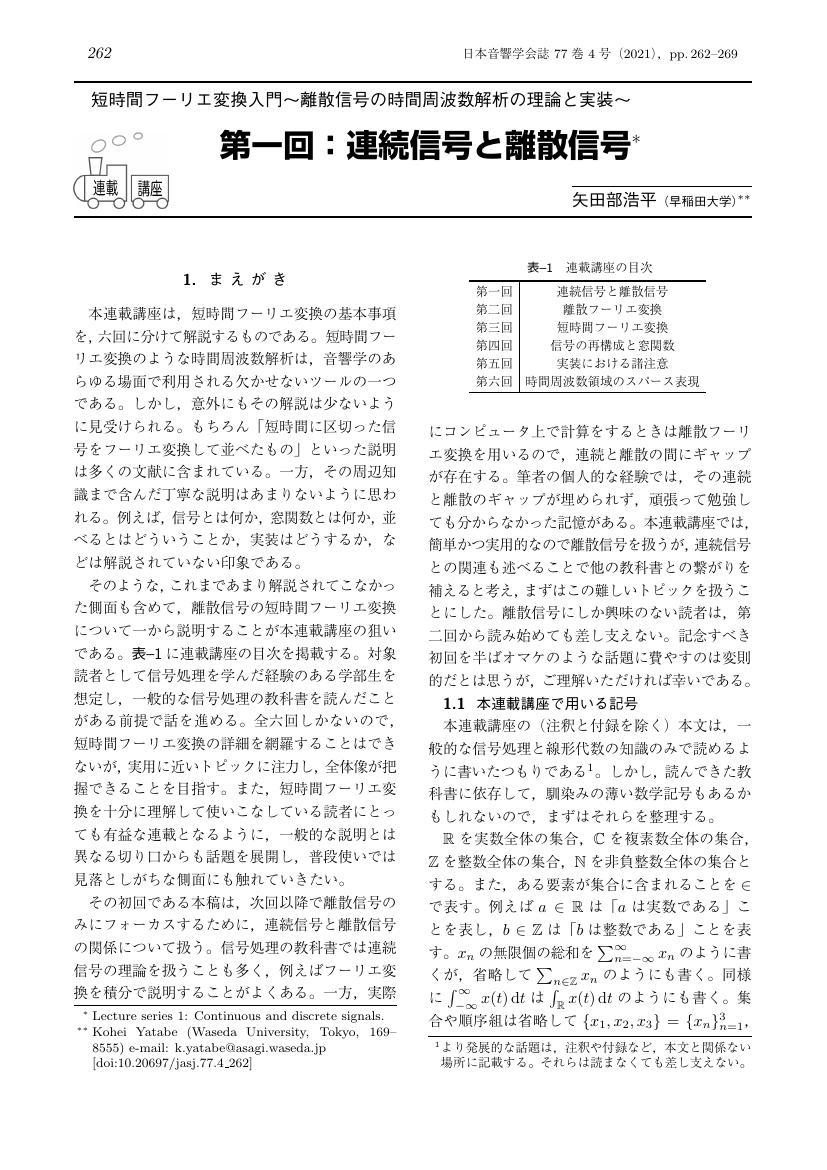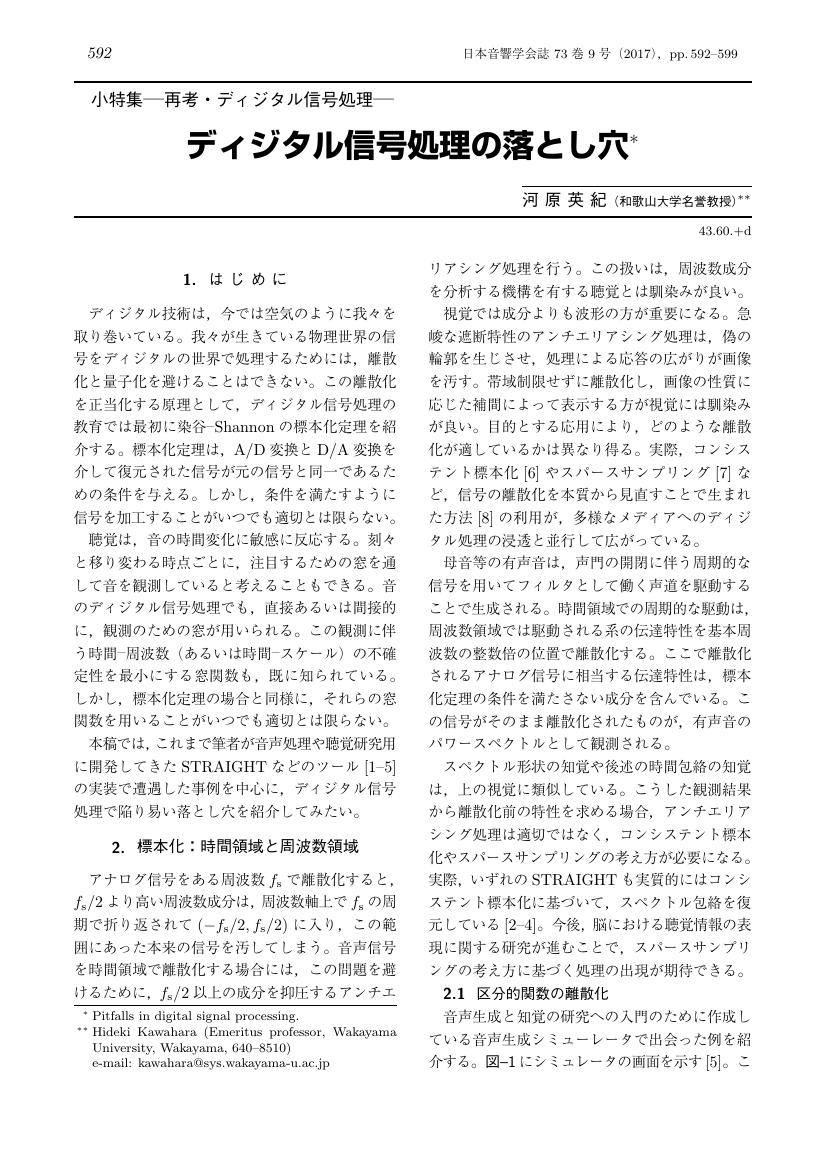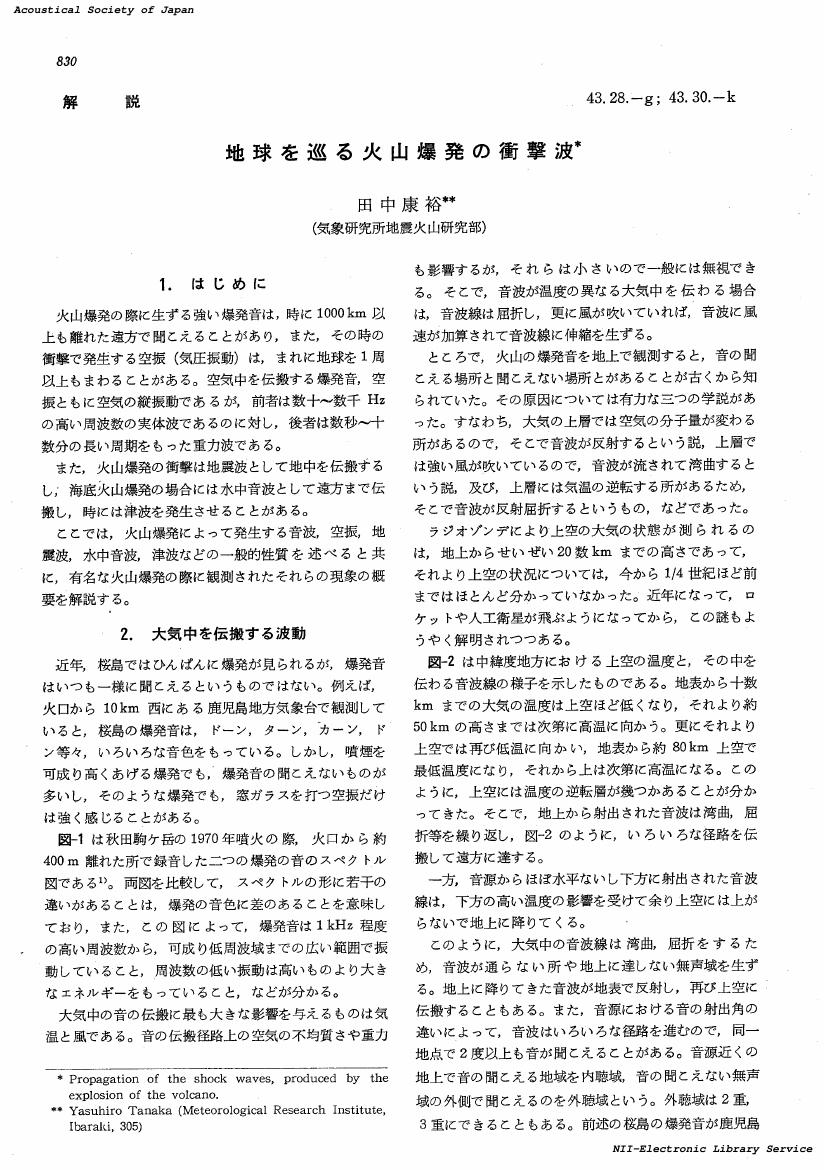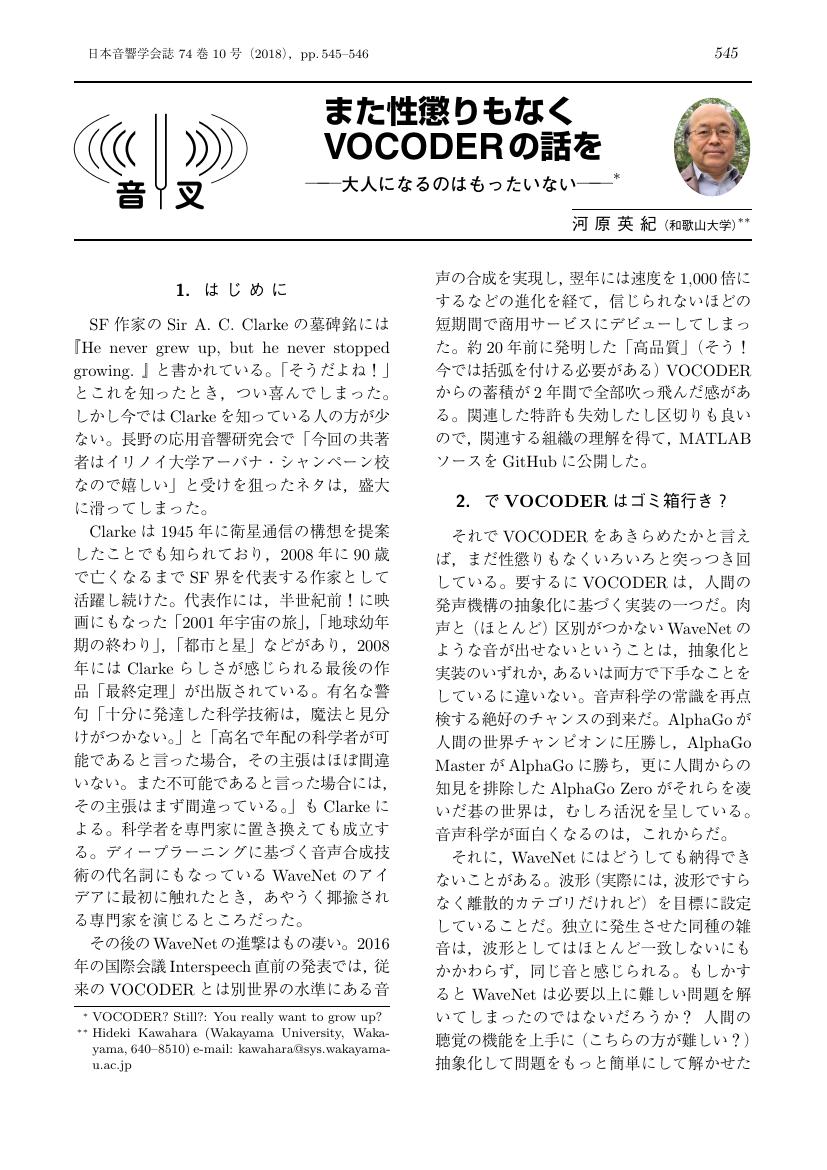188 0 0 0 OA 第一回:連続信号と離散信号
- 著者
- 矢田部 浩平
- 出版者
- 一般社団法人 日本音響学会
- 雑誌
- 日本音響学会誌 (ISSN:03694232)
- 巻号頁・発行日
- vol.77, no.4, pp.262-269, 2021-04-01 (Released:2021-05-01)
- 参考文献数
- 3
157 0 0 0 非理工系学生のための音響教育(<小特集>大学における音響教育の現状)
- 著者
- 西村 明 亀川 徹 星芝 貴行
- 出版者
- 一般社団法人日本音響学会
- 雑誌
- 日本音響学会誌 (ISSN:03694232)
- 巻号頁・発行日
- vol.65, no.5, pp.294-299, 2009-05-01
- 参考文献数
- 3
127 0 0 0 OA 梵鐘の音の部分音に関する時代的変遷
- 著者
- 大熊 恒靖
- 出版者
- 一般社団法人 日本音響学会
- 雑誌
- 日本音響学会誌 (ISSN:03694232)
- 巻号頁・発行日
- vol.54, no.2, pp.119-126, 1998-02-01 (Released:2017-06-02)
- 被引用文献数
- 1
梵鐘の音の減衰時間に時代的変遷があることを前報で示した. 本報は, 奈良時代から昭和期までに制作された梵鐘206口について, 部分音の構成に関する時代的変遷について論じる. 時代区分ごとに求めた本測定の基音周波数の近似式は, 平均で2.8%以内の精度で基音周波数を推定することができた. 梵鐘の音の基音周波数に対する部分音の周波数比は, 音の減衰時間と同じく, 梵鐘の口径と駒の爪の厚さとの割合に密接な関係があり, それらが梵鐘の音の時代的変遷の一つの要因であると推定した. また, 部分音の音圧レベル分布の時間的な変化及びスペクトル数にも時代的変遷があることを確認した.
127 0 0 0 OA 梵鐘の音の減衰時間に関する時代的変遷
- 著者
- 大熊 恒靖
- 出版者
- 一般社団法人 日本音響学会
- 雑誌
- 日本音響学会誌 (ISSN:03694232)
- 巻号頁・発行日
- vol.53, no.3, pp.208-214, 1997-03-01 (Released:2017-06-02)
梵鐘の音の特徴は, 部分音の構成, 減衰時間及びうなりにある。梵鐘は奈良時代から制作され, その様式は現代に継承されている。筆者は, 梵鐘の音の減衰時間に着目して, 奈良時代から現代までに制作された153口の丸鐘について解析した。その結果, 梵鐘の口径が大きくなると音の減衰時間が長くなる関係に時代的変遷があることを見出した。奈良期の梵鐘の音の平均減衰時間54秒に対して, 鎌倉期で24秒に短くなり, 江戸期で44秒まで長くなり, 更に昭和期では90秒と非常に長くなる傾向を示した。これらの時代的変遷は, 梵鐘の構造, 特に厚さに関係していることを推論した。焚鐘は, 現在でも年間約200口が制作されているが, それらの焚鐘の多くはうなりが長い特徴を持ち, また制作者によって音の減衰時間が異なることも確認できた。
100 0 0 0 OA ディジタル信号処理の落とし穴
- 著者
- 河原 英紀
- 出版者
- 一般社団法人 日本音響学会
- 雑誌
- 日本音響学会誌 (ISSN:03694232)
- 巻号頁・発行日
- vol.73, no.9, pp.592-599, 2017 (Released:2018-03-01)
- 参考文献数
- 38
79 0 0 0 OA 地球を巡る火山爆発の衝撃波
- 著者
- 田中 康裕
- 出版者
- 一般社団法人 日本音響学会
- 雑誌
- 日本音響学会誌 (ISSN:03694232)
- 巻号頁・発行日
- vol.40, no.12, pp.830-836, 1984-12-01 (Released:2017-06-02)
- 被引用文献数
- 1
73 0 0 0 音楽の専門家を目指す人達への音響教育 (<小特集>音響教育の現状と展望)
- 著者
- 吉川 茂 大串 健吾 山田 真司 岩宮 眞一郎
- 出版者
- 一般社団法人 日本音響学会
- 雑誌
- 日本音響学会誌 (ISSN:03694232)
- 巻号頁・発行日
- vol.55, no.3, pp.199-206, 1999
- 参考文献数
- 18
- 被引用文献数
- 1
63 0 0 0 OA IPA(国際音声記号)の基礎 : 言語学・音声学を学んでいない人のために
- 著者
- 木村 琢也 小林 篤志
- 出版者
- 一般社団法人 日本音響学会
- 雑誌
- 日本音響学会誌 (ISSN:03694232)
- 巻号頁・発行日
- vol.66, no.4, pp.178-183, 2010-04-01 (Released:2017-06-02)
- 参考文献数
- 6
61 0 0 0 OA 北方日本古代文化と秋田美人
- 著者
- 新野 直吉
- 出版者
- 一般社団法人 日本音響学会
- 雑誌
- 日本音響学会誌 (ISSN:03694232)
- 巻号頁・発行日
- vol.43, no.2, pp.133-139, 1987-02-01 (Released:2017-06-02)
57 0 0 0 OA 第二回:離散フーリエ変換
- 著者
- 矢田部 浩平
- 出版者
- 一般社団法人 日本音響学会
- 雑誌
- 日本音響学会誌 (ISSN:03694232)
- 巻号頁・発行日
- vol.77, no.5, pp.331-338, 2021-05-01 (Released:2021-06-01)
54 0 0 0 OA 商店街における音環境の実態(<小特集>公共空間における音環境マネジメント)
- 著者
- 塩川 博義
- 出版者
- 一般社団法人 日本音響学会
- 雑誌
- 日本音響学会誌 (ISSN:03694232)
- 巻号頁・発行日
- vol.70, no.3, pp.122-127, 2014-03-01 (Released:2017-06-02)
49 0 0 0 OA テキスト音声合成技術の変遷と最先端
- 著者
- 全 炳河
- 出版者
- 一般社団法人 日本音響学会
- 雑誌
- 日本音響学会誌 (ISSN:03694232)
- 巻号頁・発行日
- vol.74, no.7, pp.387-393, 2018-07-01 (Released:2019-01-01)
- 参考文献数
- 46
37 0 0 0 九官鳥の真似声構音モデル : ヘリウム音声による解析
- 著者
- 平原 達也 伊福部 達 吉本 千禎
- 出版者
- 一般社団法人 日本音響学会
- 雑誌
- 日本音響学会誌 (ISSN:03694232)
- 巻号頁・発行日
- vol.38, no.6, pp.321-329, 1982
- 被引用文献数
- 4
In order to analyze the articulation mechanism of a talking bird "Mynah, " mimic voices obtained in He- O_2 atmosphere are compared with those in the normal air based on the frequency analysis by linear prediction. A mixture of 80%-He and 20%-0_2 at one atm is used in the experiment of helium voices, and 36 mimic voices consisted of words are recorded by a taperecorder in both cases. Comparing vowel parts of normal voices with those of helium voices, it is found that the spectrum pattern of mimic voices has two types, I and II, about the structure of spectral envelope peak components. Type I shows the frequency shift in helium atmosphere and type II shows no frequency shift. Spectral envelope peak components of type I appear around 0. 8-1. 2kHz, 1. 8-2. 4kHz and 3. 8-4. 4kHz, and their frequencies do not change with vowels. On the other hand, the component of type II appears in the range from 1. 5 to 3kHz and its frequency changes with vowels. It is ascertained that (1) only the spectral envelope peak components of type I show almost the same frequency shift as those estimated by the formula describing theoretical transformation of peak frequencies, (2) spectral envelope peak frequencies of type I coincide with resonance frequencies obtained by twin-tube model of which parameters correspond to the vocal tract of Mynah, (3) the number of observed spectral envelope peaks are beyond that of the resonances calculated by twin-tube model, and (4) the observed spectral envelope coincides with one which is obtained by adding a component of type II to the spectral envelope estimated from the source-system model using spectral envelope peaks of type I as poles. From above results and analyses, it is confirmed that type I has multi peak components which are formed by resonances of the vocal tract, and type II has a single peak component which may not be formed by the resonance. Furthermore, it is assumed that Mynah's syrinx may produce two components as sound sources. The first one has a wide range spectrum composed of pitch and its harmonics, which is similar to the sound source by human's vocal cord. The second one has a higher frequency component corresponding to type II. This hypothesis may be also supported by the anatomical structure of the syrinx. From above considerations, it is concluded that Mynah may produce the vowel part of mimic voices by controlling the frequency of the second sound source in addition to use almost fixed resonance components obtained by its vocal tract.
35 0 0 0 OA 小鳥の音声が伝えるもの ――さえずりと地鳴きの仕組みと機能――
- 著者
- 橘 亮輔
- 出版者
- 一般社団法人 日本音響学会
- 雑誌
- 日本音響学会誌 (ISSN:03694232)
- 巻号頁・発行日
- vol.79, no.1, pp.28-33, 2022-12-25 (Released:2023-02-01)
- 参考文献数
- 41
34 0 0 0 OA 情動表出としてのげっ歯類超音波発声 ――マウスとラットにおける音声コミュニケーション――
- 著者
- 岡部 祥太 菅野 康太
- 出版者
- 一般社団法人 日本音響学会
- 雑誌
- 日本音響学会誌 (ISSN:03694232)
- 巻号頁・発行日
- vol.79, no.1, pp.41-48, 2022-12-25 (Released:2023-02-01)
- 参考文献数
- 74
33 0 0 0 OA また性懲りもなくVOCODERの話を
- 著者
- 河原 英紀
- 出版者
- 一般社団法人 日本音響学会
- 雑誌
- 日本音響学会誌 (ISSN:03694232)
- 巻号頁・発行日
- vol.74, no.10, pp.545-546, 2018-10-01 (Released:2019-04-01)
32 0 0 0 OA ガウス過程・深層ガウス過程とそれらの音声情報処理への応用
- 著者
- 郡山 知樹
- 出版者
- 一般社団法人 日本音響学会
- 雑誌
- 日本音響学会誌 (ISSN:03694232)
- 巻号頁・発行日
- vol.76, no.2, pp.109-116, 2020-02-01 (Released:2020-08-01)
- 参考文献数
- 32
32 0 0 0 OA インタフェース・デザインの勘所
- 著者
- 加藤 淳
- 出版者
- 一般社団法人 日本音響学会
- 雑誌
- 日本音響学会誌 (ISSN:03694232)
- 巻号頁・発行日
- vol.77, no.4, pp.231-238, 2021-04-01 (Released:2021-05-01)
- 参考文献数
- 32
31 0 0 0 OA 乳幼児期における音声の特異性,情動性,相互性 ――音声言語発達を促す動因――
- 著者
- 皆川 泰代 星野 英一 徐 鳴鏑
- 出版者
- 一般社団法人 日本音響学会
- 雑誌
- 日本音響学会誌 (ISSN:03694232)
- 巻号頁・発行日
- vol.79, no.1, pp.49-56, 2022-12-25 (Released:2023-02-01)
- 参考文献数
- 63
- 著者
- 香田 啓貴
- 出版者
- 一般社団法人 日本音響学会
- 雑誌
- 日本音響学会誌 (ISSN:03694232)
- 巻号頁・発行日
- vol.79, no.1, pp.34-40, 2022-12-25 (Released:2023-02-01)
- 参考文献数
- 33














